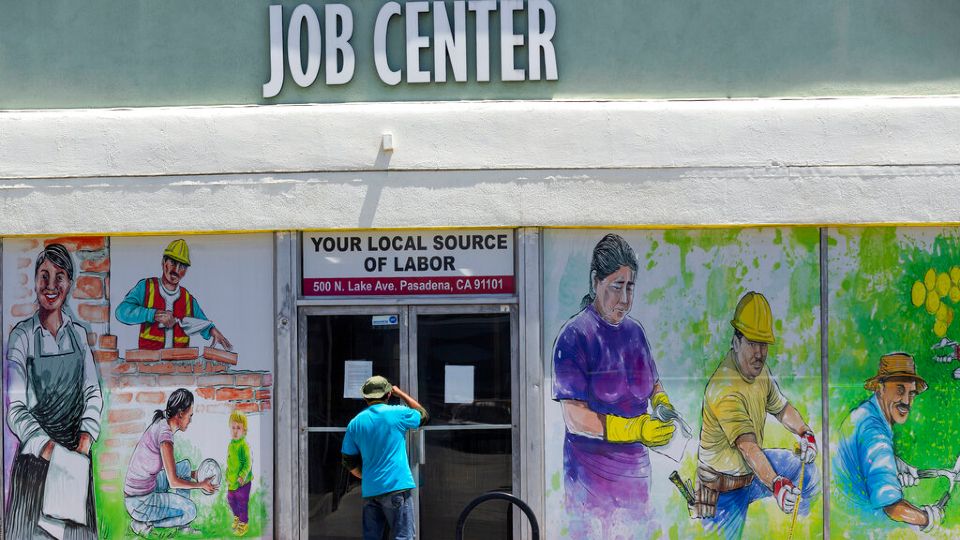WASHINGTON — The number of laid-off workers seeking unemployment benefits remained stuck at 1.3 million last week, an historically high level that indicates many companies are still cutting jobs as the viral outbreak intensifies.
What You Need To Know
- Labor Department states jobless aid applications fell
- Total number of people who are receiving jobless benefits dropped 400,000 to 17.3M
The elevated level of applications for jobless aid is occurring as new confirmed cases of coronavirus are spiking across much of the Sunbelt, threatening to weaken the economic recovery. Case counts are rising in 40 states, and 22 states have either paused or reversed their efforts to reopen their economies, according to Bank of America.
The Labor Department’s Thursday report showed that applications for jobless aid fell by about 10,000 from the previous week. The figure has now topped 1 million for 17 straight weeks. Before the pandemic, the record high for weekly unemployment applications was nearly 700,000.
The total number of people who are receiving jobless benefits dropped 400,000 to 17.3 million, the government said. That suggests that some companies are continuing to rehire workers, which could offset some of the job losses reflected in the still-high level of claims.
An additional 928,000 people sought benefits last week under a separate program for self-employed and gig workers that has made them eligible for aid for the first time. These figures aren’t adjusted for seasonal variations, so the government doesn’t include them in the official count.
The resurgence of the virus and new business shutdowns in states such as Florida and California, along with signs that consumers are pulling back from eating out and other activities, has intensified fears that the economic recovery is losing steam.
The government’s employment report for June showed a solid gain of 4.8 million jobs and an unemployment rate that fell to 11.1% from 13.3%.
But economists increasingly doubt that such a pace can be sustained. The number of employees working at small businesses declined last week, particularly in states with worsening viral outbreaks, according to data from Homebase, a company that makes scheduling and work-tracking software.
THIS IS A BREAKING NEWS UPDATE. AP’s earlier story follows below.
Unemployment remains painfully high in the U.S. even as economic activity slowly picks up.
That reality will be on display Thursday morning when the U.S. government releases data on how many workers sought unemployment benefits last week, as well as how retailers did in June.
Both reports will be closely watched as new confirmed cases of coronavirus rise in 40 states, including huge spikes in California, Texas and Florida. Surging infections threaten to slow the nascent economic recovery.
“The risk of a dip lower in the economy has increased as more states adopt policies to combat the virus spread,” economists at Bank of America said in research note. “Until the country manages to get the virus under control, the recovery is likely to be one of fits and starts.”
Applications for jobless aid are expected to remain stuck at the worrisome level of around 1.2 million, the 17th straight week of claims above the 1 million mark. Before the pandemic intensified in mid-March, the highest weekly figure on record was about 700,000.
Sales at retail stores and restaurants likely rose 5.4% in June, according to data provider FactSet. That would follow a record gain of nearly 18% in May as shops, restaurants and bars reopened after nationwide shutdowns in the previous months, when sales plummeted. Still, sales will likely remain sharply below their levels of a year ago. California, Florida and other states have closed down bars for a second time and barred indoor dining because cases are surging.
The government’s employment report for June showed a solid gain of 4.8 million jobs and an unemployment rate that fell to 11.1%, from 13.3%.
But it’s not clear that such a pace can be sustained. The number of employees working at small businesses declined last week, particularly in states with worsening viral outbreaks, according to data from Homebase, a company that makes scheduling and work-tracking software.
And companies continue to lay off people. American Airlines warned its workers Wednesday that it may have to cut up to 25,000 jobs in October because of sharply reduced air travel. Airlines are barred from layoffs until then as a condition of federal aid they have received. United Airlines has already told 36,000 workers they may lose their jobs.



